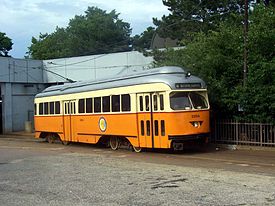- Ashmont–Mattapan High Speed Line
-
Ashmont–Mattapan High Speed Line 
M-Line PCC trolley car #3254 leaves Ashmont Station. August 2005.Overview Type Trolley Locale Boston, Massachusetts (Dorchester to Mattapan) via Milton, Massachusetts Termini Ashmont
MattapanStations 8 Services 1 Daily ridership 4,586[1] Operation Opened 1929 Owner MBTA Operator(s) MBTA Character Grade-separated ROW Rolling stock PCC streetcar Technical Line length 2.6 mi (4.2 km) Track gauge 4 ft 8 1⁄2 in (1,435 mm) Minimum radius 43 ft (13.106 m) [2] Electrification Overhead lines Route map The Ashmont–Mattapan High Speed Line or also known as the "M-Line" in Boston and Milton, Massachusetts is considered to be part of the MBTA's Red Line, even though it uses different equipment (streetcars) and passengers have to change at Ashmont. The only MBTA line to run through a cemetery, the line opened on August 26, 1929. The term 'high speed line' is vestigial, as the route is neither characterized by a fully dedicated, grade separated right-of-way, nor by high-speed rolling stock.
Contents
History and geography
The Ashmont–Mattapan Line follows the original right-of-way of the passenger and freight steam railway line that opened in December 1847 as the Dorchester and Milton Branch Railroad. That line later became part of the Old Colony Railroad and then the New York, New Haven and Hartford Railroad after 1893. The steam-powered trains were discontinued in 1927 and the line was closed for two years while it was being modified for streetcar service. There was a debate at that time whether or not to continue the same subway trains from Boston to Ashmont and on to Mattapan without a need for passengers to switch to streetcars at Ashmont. Apparently, the added cost of full-scale subway service along the remainder of the route was considered to be too high. The right-of-way is owned by the MBTA and has only two at-grade crossings on its 2.6-mile route.
The portion of the line from Ashmont to Cedar Grove and through the cemetery follows the path of the original Shawmut Branch of the Old Colony Railroad, which opened in 1872. The cemetery is the point where the Shawmut Branch intersects with the original Dorchester and Milton Branch.
The line's longest shutdown occurred June 24, 2006 while the Ashmont and Mattapan stations were renovated. Service was restored on December 22, 2007.[3] Several of the stations have been renovated for better accessibility and modernization; all stations except Valley Road are now accessible. (Valley Road is located down a grade from the nearest road and there is no room for a ramp).
Rolling stock
The rolling stock of the Ashmont–Mattapan Line consists of rebuilt PCC streetcars that formerly ran on the Green Line. A similar streetcar can be seen in a side tunnel at Boylston station on the Green Line.
Future
Using funding from the American Recovery and Reinvestment Act of 2009, the MBTA is conducting a pilot test of technology similar to a collision avoidance system in an automobile. It would use radar and increasingly fast beeping to warn train operators of obstacles ahead. Like positive train control, it would stop the train if the driver did not take action to avoid an impending collision.[4] If successful, the system would be considered for deployment on the Green Line, where several collisions had recently occurred.
Stations
- Ashmont (transfer to Dorchester branch of the Red Line)
- Cedar Grove
- Butler
- Milton
- Central Avenue
- Valley Road
- Capen Street
- Mattapan
Gallery
References
- ^ "Ridership and Service Statistics". Massachusetts Bay Transportation Authority. 2010. http://www.mbta.com/uploadedfiles/documents/Bluebook%202010.pdf. Retrieved 11 August 2011.
- ^ Transportation Research Board Executive Committee 1995 (1995). "Applicability of Low-Floor Light Rail Vehicles in North America". US Federal Transit Admininstration. http://onlinepubs.trb.org/Onlinepubs/tcrp/tcrp_rpt_02.pdf. Retrieved 11August 2011.
- ^ "Mattapan Trolley to Re - Open". Massachusetts Bay Transportation Authority. 20 December 2007. http://www.mbta.com/about_the_mbta/news_events/?id=14165&month=&year=. Retrieved 24 December 2007.
- ^ Associated Press (2 July 2009). "MBTA testing trolley collision-avoidance system". Boston Herald. http://www.bostonherald.com/news/regional/view/20090702mbta_testing_trolley_collision-avoidance_system/srvc=home&position=recent. Retrieved 11 August 2011.
External links
- MBTA: Red Line
- MBTA: Ashmont Station renovation
- MBTA: Mattapan Station renovation
- MBTA: Further Mattapan renovations
 Massachusetts Bay Transportation Authority
Massachusetts Bay Transportation AuthoritySubway lines
(List of stations)Blue Line • Green Line ("B" Branch · "C" Branch · "D" Branch · "E" Branch) • Orange Line • Red Line (Ashmont–Mattapan High Speed Line)




Commuter
Rail lines
(List of stations)Fairmount • Fitchburg • Framingham/Worcester • Franklin • Greenbush • Haverhill • Kingston/Plymouth • Lowell • Middleborough/Lakeville • Needham • Newburyport/Rockport • Providence/StoughtonBus routes
(List of routes)Silver Line • Crosstown routes • Key routes • Trackless trolleys • Routes in East Boston, Chelsea, and Revere • Routes in Melrose, Reading, Stoneham, and Wakefield • MBTA bus routes in North Shore, Massachusetts • Routes in South BostonUnder construction South Coast RailProposed lines Green Line Extension • North–South Rail Link • Urban Ring ProjectFormer lines Other Accessibility • Arts on the Line • Boat • Boston-area streetcar lines • "Charlie on the M.T.A." • CharlieCard • History • Police • Nomenclature • Newton rail accident • The RideCurrently operating light rail and streetcar systems in the United States ArkansasArizonaCaliforniaMUNI: Cable Car, F Market & Wharves, and Metro lines · Metro Rail: Blue Line, Green Line and Gold Line · Sacramento RT · San Diego Trolley · Sprinter · Santa Clara VTA · Waterfront Red CarColoradoFloridaGeorgiaRiver Street StreetcarLouisianaMassachusettsAshmont–Mattapan High Speed Line · MBTA Green LineMarylandMinnesotaMissouri / IllinoisNew JerseyNew YorkNorth CarolinaOhioOregonPennsylvaniaPittsburgh Light Rail · SEPTA Routes 15, 101, 102, and Subway–Surface LinesTennesseeTexasUtahVirginiaWashingtonLink Light Rail · Seattle Streetcar NetworkWisconsinCategories:- 1929 establishments
- Streetcars in the Boston area
- Old Colony Railroad lines
- Red Line (MBTA)
- Light rail in Massachusetts
- Standard gauge railways in the United States
Wikimedia Foundation. 2010.





